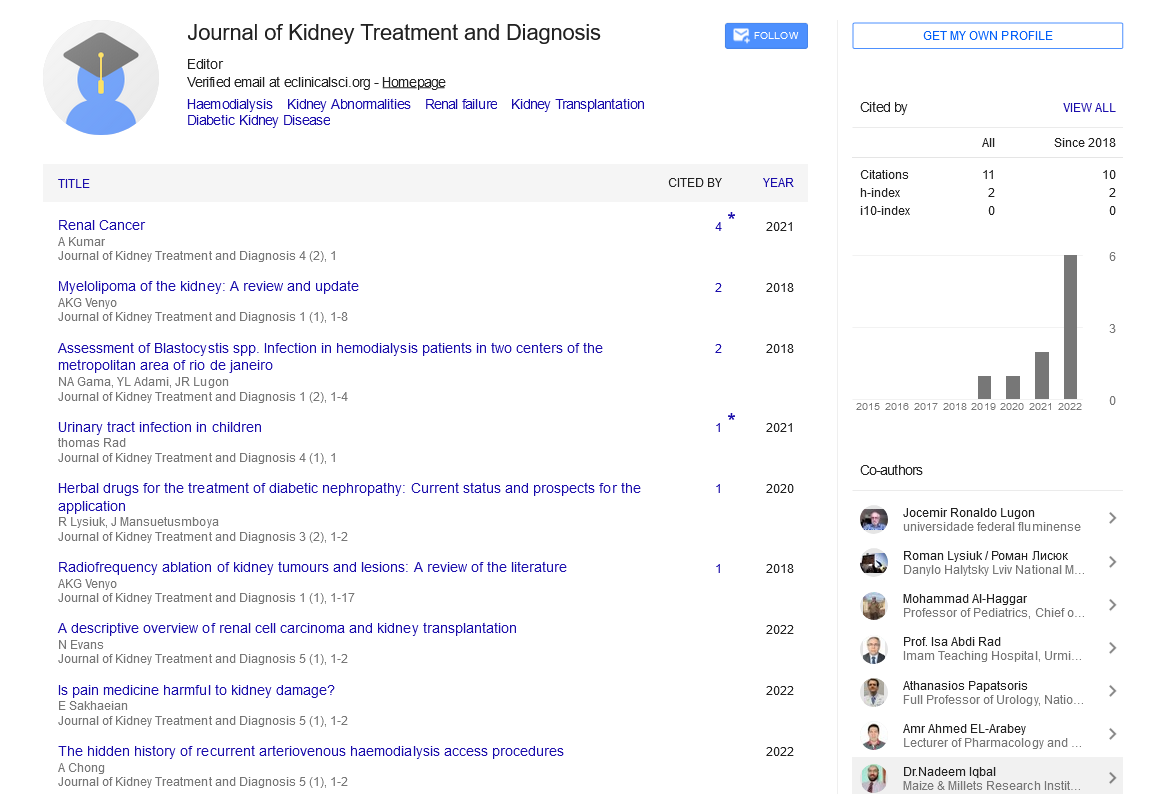Novel pharmacological developments for the treatment of diabetic kidney disease
Received: 21-Jan-2023, Manuscript No. PULJKTD-23-6181; Editor assigned: 24-Feb-2023, Pre QC No. PULJKTD-23-6181 (PQ); Reviewed: 14-Mar-2023 QC No. PULJKTD-23-6181; Revised: 25-Apr-2023, Manuscript No. PULJKTD-23-6181 (R); Published: 03-May-2023
Citation: Johnston E, Dansin E. Novel pharmacological developments for the treatment of diabetic kidney disease. J Kidney Treat Diagn 2023;6(1):1.
This open-access article is distributed under the terms of the Creative Commons Attribution Non-Commercial License (CC BY-NC) (http://creativecommons.org/licenses/by-nc/4.0/), which permits reuse, distribution and reproduction of the article, provided that the original work is properly cited and the reuse is restricted to noncommercial purposes. For commercial reuse, contact reprints@pulsus.com
Abstract
In addition to being one of the main consequences of diabetes, Diabetic Kidney Disease (DKD) is also the main cause of End Stage Renal Disease (ESRD). The incidence and progression of DKD have long been important clinical issues that raise morbidity and death while severely impairing people's quality of life. DKD can progress more slowly if blood sugar, blood pressure, blood lipids, and lifestyle factors are managed.
A growing number of new drugs are being developed based on extensive research into the pathological and molecular causes of DKD. Examples include Sodium Glucose Cotransporter 2 (SGLT2) inhibitors, Glucagon Like Peptide-1 (GLP-1) inhibitors, and Dipeptidyl Peptidase-4 (DPP-4) inhibitors, all of which have demonstrated good clinical efficacy. Aside from that, there are a number of recently created medications, such as Protein Kinase C (PKC) inhibitors, Advanced Glycation End product (AGE) inhibitors, aldosterone receptor inhibitors, Endothelin Receptor (ETR) inhibitors, Transforming Growth Factor- (TGF-) inhibitors, Rho Kinase (ROCK) inhibitors, and others, that have shown promise in animal or clinical trials for the treatment of DKD.
Keywords
Glucagon; Diabetic Kidney Disease (DKD); Peptides; Glucose; Protein
Introduction
Chronic Kidney Disease (CKD) brought on by diabetes mellitus is known as Diabetic Kidney Disease (DKD) (DM). Complex pathophysiology leads to end stage renal disease, which is defined by increasing excretion of chronic albuminuria and/or progressive decline in Glomerular Filtration Rate (GFR) (ESRD). Due to the rising incidence of DKD, which has now overtaken diabetes as the major cause of ESRD, the prevalence of diabetes is rising globally today. Around 30%–50% of ESRD worldwide is brought on by DKD. DKD raises the risk of cardiovascular and cerebrovascular disorders in addition to being the primary cause of ESRD. According to a global survey conducted by the International Diabetes Federation (IDF), 2% of type 2 diabetic individuals have cardiovascular risk factors or have had cardiovascular events.
Description
The fraction of diabetes individuals who develop ESRD can be decreased by clinical basic treatment, which includes control of hyperglycemia, hypertension, hyperlipidemia, quitting smoking and altering diet. Yet, this fundamental therapy cannot successfully reduce increasing DKD. Studies on the pathophysiological and molecular processes of DKD are becoming increasingly and more prevalent, in addition to metformin and RAAS receptor inhibitors created earlier in time. This has led to the development of an increasing number of new medications in recent years, such as Sodium Glucose cotransporter 2 (SGLT2) inhibitors, Glucagon Like Peptide-1 (GLP-1) receptor antagonists, Dipeptidyl Peptidase-4 (DPP-4) inhibitors, Protein Kinase C (PKC) inhibitors, Advanced Glycation End products (AGE) inhibitors, Endothelin (ET) receptor antagonist etc.
While some of them have been successfully utilized in the clinical treatment of DKD, others are currently being researched or are awaiting the Food and Drug Administration's Approval (FDA). Additionally, it was discovered that a number of medications not intended for the treatment of DKD also play a significant role in the development of the disease, including the anti-angina drug nicorandil, the anti-allergic medication tranilast, the tetracyclic antibiotic doxycycline, the antibody FG-3019, and various substances such as bardoxolone methyl and probucol. However, more clinical trials are still required to fully understand how they affect DKD. Despite the fact that there are medications available for the treatment of DKD, the multiple mechanisms at play make it challenging to select the most effective course of action.
Use of novel hypoglycemic medications
Both preventing and treating DKD can be accomplished with the use of early metformin and RAAS inhibitors like ACEI/ARB. Nonetheless, DKD progression is still inevitable, making the need for a new medication urgent. A growing number of novel medications are being developed nowadays that are based on studies on the pathogenic mechanism and molecular mechanism of DKD. Three new hypoglycemic medication classes SGLT2 inhibitors, GLP-1 receptor antagonists, and DPP-4 inhibitors show promising kidney protective benefits.
Other possible new medications
In the course of the studies, it was discovered that many medications not intended for the treatment of DKD also play a part in its development. Examples include the anti-angina drug nicorandil, the anti-allergic medication tranilast, the tetracyclic antibiotic doxycycline, the antibody FG-3019, and various substances such as bardoxolone methyl and probucol.
Conclusion
With an increase in DM, DKD incidence will also rise. Although blood pressure, blood lipids, and glucose management can slow the progression of DKD, ESRD will eventually result from DKD. We need to do more in-depth study on the mechanism of DKD and the relevant medications in order to attain more effective efficacy. The research of DKD have advanced significantly in recent years, from the therapeutic mechanism to the emergence of specific medications, in addition to metformin and ACEI/ARB in the early years. Clinical trials have demonstrated very strong efficacy for the recently marketed hypoglycemic medications, including SGLT2 inhibitors, GLP-1 inhibitors, and DDP-4 inhibitors.
Most medications are currently undergoing testing at various levels of development. Large-scale RCT studies are being conducted increasingly frequently to help DKD sufferers as soon as possible.





